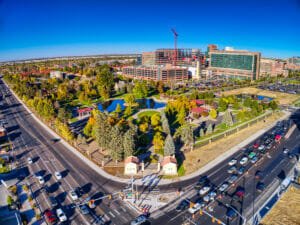News
Just What the Doctor Ordered for Healthcare and Research Facilities
“An ounce of prevention is worth a pound of cure.” ~ Ben Franklin
One of Mr. Franklin’s most famous quotes, this pearl of wisdom is often used in the context of health and wellness, which makes sense given his choice of words. However, it might surprise you that this advice was originally offered as a commentary on the value of preventing fires as opposed to the cost of fighting them.
When it comes to ensuring wind-related resiliency in healthcare and medical research environments, this time-honored saying rings particularly true—metaphorically speaking. Diagnose and address potential hazards early in the design process or risk fighting fires later.
Anticipating problems early is a wise practice that rarely fails to yield significant value, be that in terms of immediate design and development or avoiding future (and often more costly) consequences of failing to do so. It occurs to us that architects specializing in healthcare and medical research facilities would do well to consider another well-known Greek saying attributed to the father of modern medicine:
“First, do no harm.” ~ Hippocrates
It’s a maxim that applies not only to the current situation but also to any foreseeable harm that may occur in the future. Fortunately, this arena of proactively diagnosing and avoiding aero-architectural and environmental air quality issues is where CPP Wind truly excels.

CPP Wind specializes in helping healthcare architects fully understand their project’s aero-architectural dynamics early in the design process. This proactive approach adds significant value by uncovering more efficient and sustainable design options; increasing occupant health, comfort, and productivity; lowering energy costs; and reducing risk and liability. And, as in the “ounce of prevention” metaphor, we help ensure a healthy environment is maintained at the time of initial occupancy and throughout the life of the building itself—without the need for more expensive retrofits and mitigation solutions.
We focus on five key factors specific to the healthcare and research facility space:
- Preventing unhealthy recirculation of odors, exhausts, and other environmental contaminants
- Helping cladding and structural engineers leverage materials to reduce costs and increase resiliency
- Creating a more hospitable outdoor environment with safe and comfortable amenity areas, healing gardens, entries, and walkways
- Understanding indoor airflow relative to workspaces, patient care areas, and lab facilities
- Preventing and mitigating wind-related door operability issues to ensure safe and easy ingress/egress
By engaging CPP Wind early in the design process, architects and designers can help avoid exhaust dispersion and other potential afflictions long before a ceremonial shovel breaks ground on the project.

Of course, many outstanding healthcare and research facilities were designed and constructed without the benefit of today’s modern air movement and wind modeling technology. Construction projects that did not have the advantage of inoculating themselves against these types of wind and air movement issues in the design phase frequently present a similar symptom—odor. Whether it’s an operating room that smells like cafeteria french fries or patient rooms awash in helicopter or emergency generator fumes, the result is the same. Environmental health is compromised, employee performance is affected, and patient care is at risk.
The good news is that, just as our understanding of the complex systems that comprise the human body and scientific advancements have transformed the world of medicine, so, too, have advancements in aero-architectural dynamics benefited the built environment. The expert consultants at CPP Wind are among the best in the world at diagnosing and treating environmental ailments that can compromise the quality of care, negatively impact costs, and prevent people from operating at their best.
To learn more about how CPP Wind can deliver significant long-term value to your healthcare or medical research project or existing facility, view our Healthcare Design and Safety informational flyer or contact us today to speak with one of our wind engineering experts.
